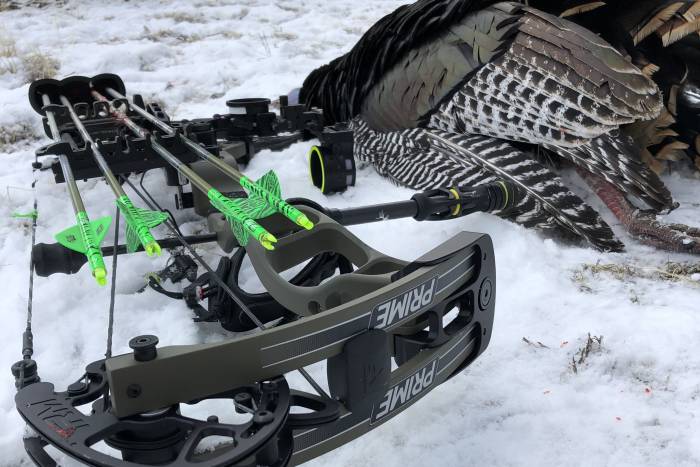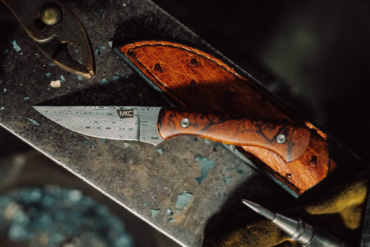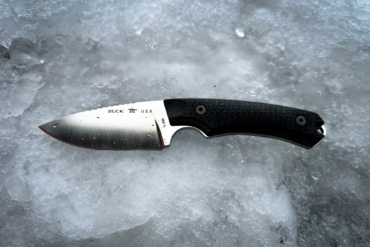Easton’s latest FMJ incarnation promises stealth and accuracy. And it’s got the price tag to prove it.
Few arrows have won the hearts and minds of bowhunters like Easton’s Full Metal Jacket line. Some say it’s the branding. Others note the shaft’s racy look. Not me.
I credit Easton innovation, a carbon core wrapped in a 7075-aluminum jacket, and various spine sizes and GPI (grains per inch) ratings in 4mm, 5mm, and 6mm offerings. And I credit downrange accuracy and undeniable penetration.
Arrows don’t become quiver-fillers because of sexy looks or marketing jargon. Arrows become quiver-fillers when they perform perfectly shot after shot. The FMJ line fills quivers — lots of quivers.
Not one to rest on its successes, Easton once again raises the bar for arrows. Enter the latest member of the FMJ family: the Taper T64.
The Gist
The idea behind this shaft was simple: increase FOC (front of center), boost downrange performance, and increase penetration. How did Easton accomplish this? The Taper T64 starts at the insert end with a 6mm diameter and tapers to a diameter of 4 mm at the nock end.
This design increases FOC by nearly 30%, which leads to increased downrange consistency. The taper from 6 to 4 mm also reduces friction because the narrower shaft can track behind the 6mm insert end as it passes through the target. This results in maximum penetration and more pass-throughs on big game.
Building ‘Em Out

These shafts are sexy, and you can easily see the taper. There are lots of questions floating around about how to cut these shafts so as not to affect the taper. It’s easy. Easton has provided a Max Cut line, located in the 6mm section of the shaft. Cut your arrows in front of this line, and you’re good. Cut behind the line, and you’ll have issues.
The shafts are available as bare shafts and can be purchased only through authorized Easton retailers. If you don’t have an arrow saw, be sure to have your pro shop cut them down to size for you.
Those of you familiar with building 4mm and 5mm FMJ shafts will have a bit of a surprise. The Taper T64 shafts come with no grinding stone or HIT (hidden insert technology) tool. That’s because the inserts are RPS (replaceable point system) style.
In short, they’re basic Easton inserts that don’t hide up inside the shaft. After cleaning the carbon with a Q-tip, apply your insert glue of choice and twist and turn the insert — being sure to spread glue across the shaft’s inner diameter — until it seats up against the shaft. My finished arrow length with inserts was just a tick under 29 1/16 inches.
I’m a big fan of arrow wraps. They help me track my arrow in flight and locate it after a hit on an animal. I wrapped my arrows with 1-inch Bohning Blazer Wraps and fletched them on a Bitzenburger jig. My vane of choice was Bohning’s 2-inch Blazer Vane. The finished arrow weight with an attached 100-grain point was 514.8 grains.
Close Range

Even inside a pro shop where sound tends to reverberate off the walls, the Taper T64 added an element of hush to my bow. I appreciated that. My first mission was to make sure the arrow worked well with my Prime Logic CT5. It did.
Paper tuning took less than 3 minutes. At a distance of 20 yards, I stacked a bare shaft and a pair of fletched shafts inside a 1-inch dot. I couldn’t wait to get the shaft outside and stretch its legs.
The arrow’s speed was surprising. I expected a much slower fps rating than 264 fps. This was a four-shot speed average. Three of the four were duplicate 264 fps readouts, and the other showed 265. My Logic CT5 was set at 70.1 pounds with a draw length of 29 inches.
This combo produced a kinetic energy rating of 79.53 foot-pounds. That’s enough energy to tackle moose and grizzly bear. You can almost feel the wallop when the arrow impacts foam.
Target Practice
I’ve spent time — a lot of time — shooting Easton’s 4mm, 5mm, and 6mm FMJs. They are amazing shafts. The Taper T64 is equally amazing. This projectile proved to be a downrange tack driver. My offhand groups from 20 to 100 yards were incredible. I shot three-arrow groups fitted with field points, mechanical heads, and fixed-blade heads at each distance.
Typical accuracy at the longer 60 to 100 ranges were sub-4 inches. That’s taking an average of all head styles. This arrow steers whatever you want to screw into it. Of course, like the rest of the FMJ line, the Taper T64 pulls effortlessly from foam targets.
I did shoot the Taper T64 through my Hooter Shooter. The results were what you’d expect — same-hole accuracy regardless of distance. Tip: If you own a Hooter Shooter or go to your pro shop and test your arrows through one, don’t shoot groups. This is especially important if you’re shooting fixed-blade broadheads. You’ll end up with lots of damaged shafts.
For fun, I shot a 10 target 3D score. The closest shot I took was from 58 yards, and the farthest was 82. Out of a possible 100, I shot a 98: one 12-ring, seven 10-rings, and two eight-rings.
The shafts were even quieter outside. I set up a high-definition microphone downrange and compared the noise level of the Taper T64 with three other popular carbon shafts. The readings don’t lie: The Taper T64 was considerably quieter.
Performance Worth the Price?

At $300 per dozen, these shafts do cut into the pocketbook. Yes, Easton knows this. The company’s goal with the Taper T64 was to provide a premium product for bowhunters seeking next-level arrow performance. Easton wanted to add a lethal new member to the FMJ line.
Whether these arrows are worth the price is up to you. I will say that my testing proved them to be Easton’s best FMJ incarnation to date, and I can’t find a single negative thing to say about them.






